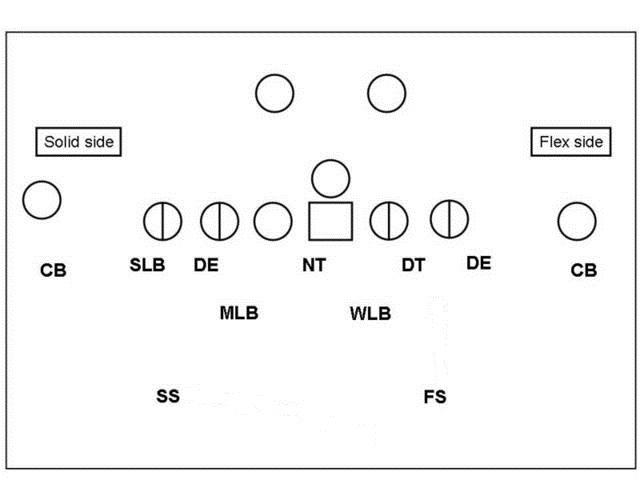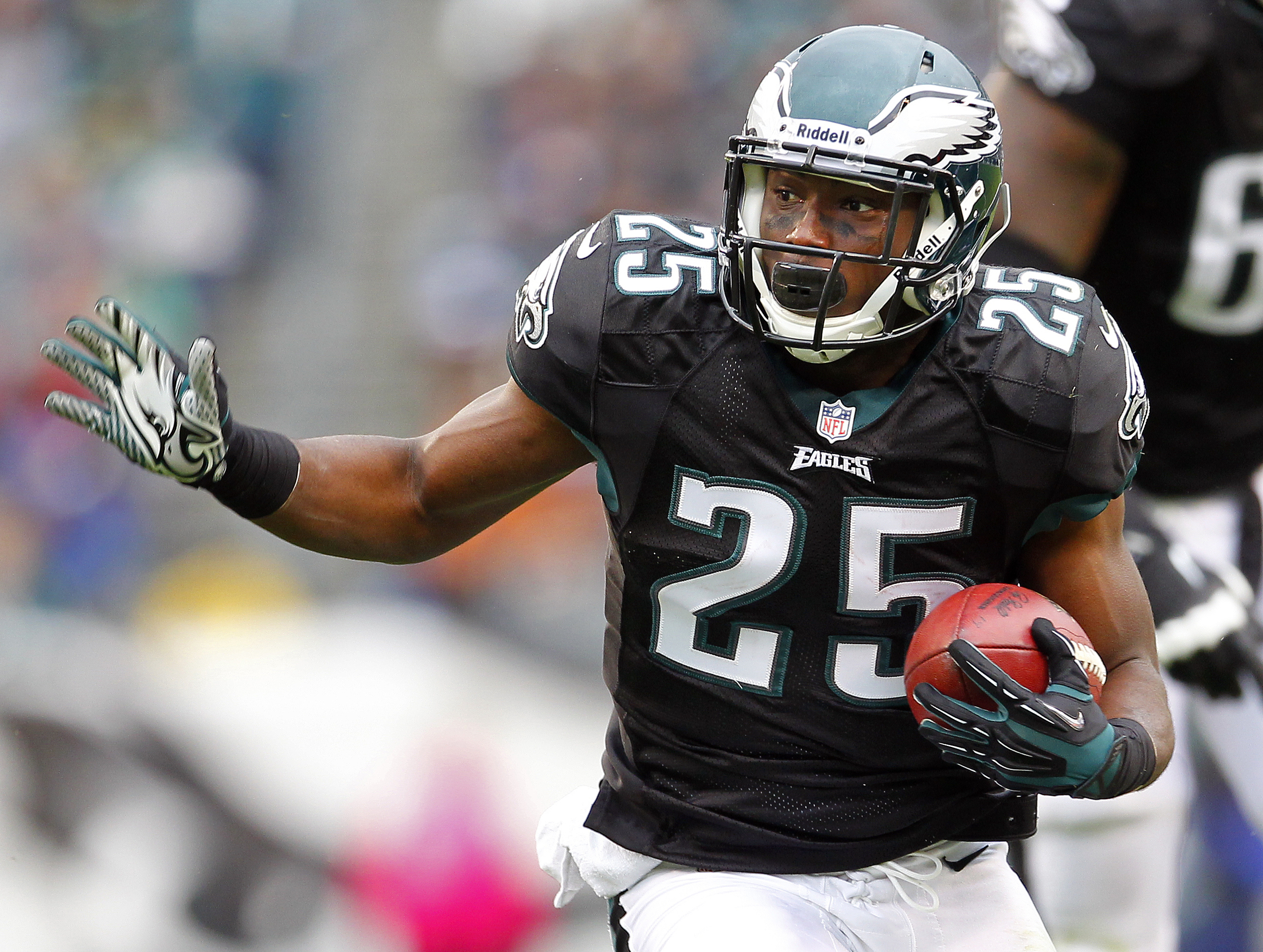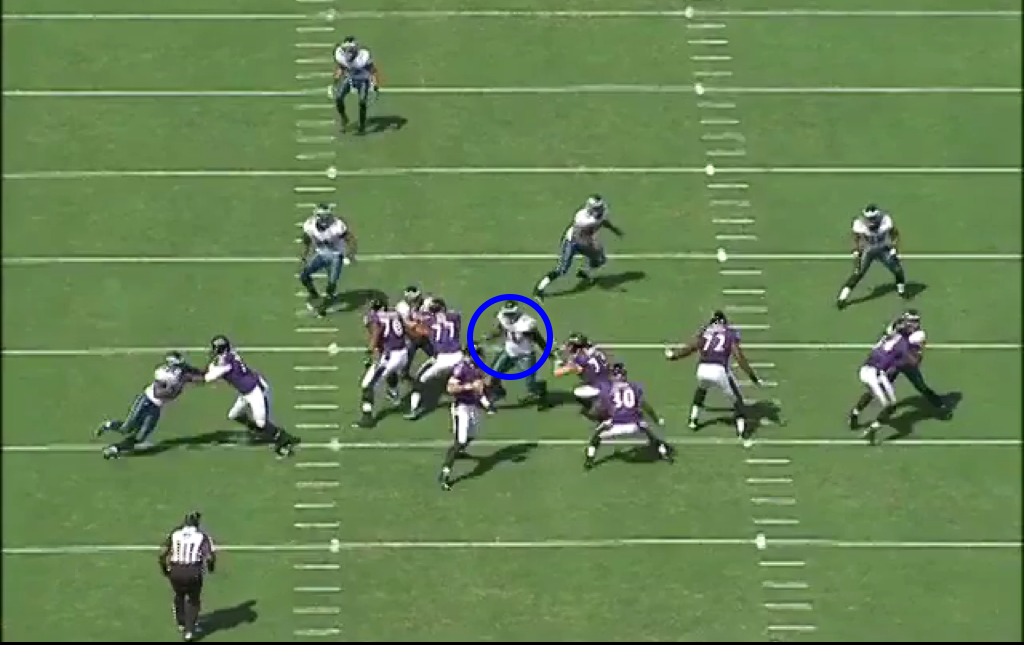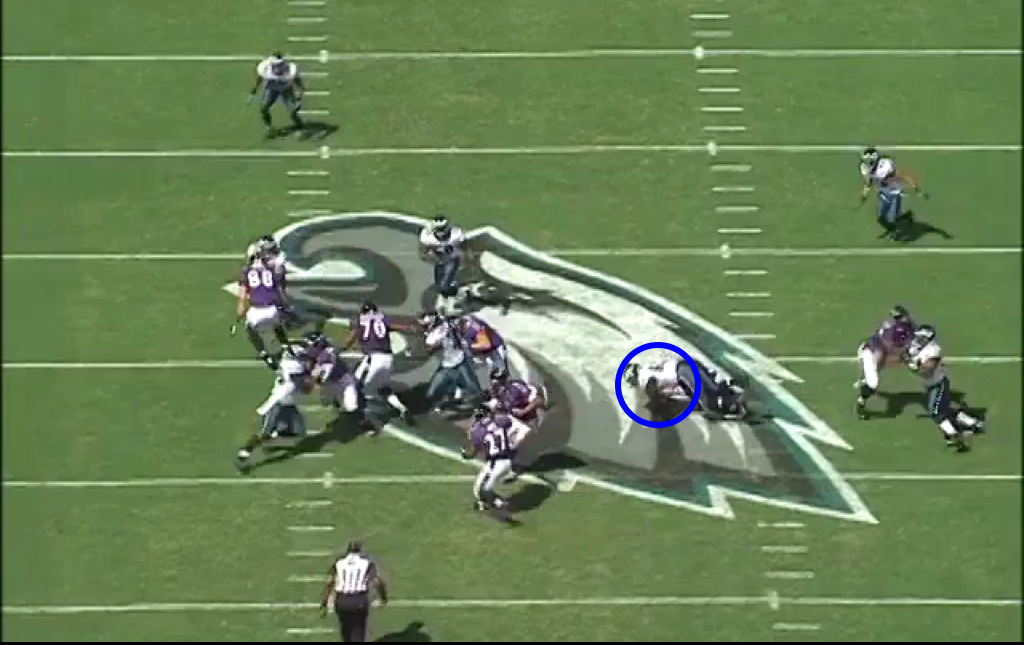The following is an article I wrote that originally appeared in the Eagles Almanac 2015 with the title "Keep Your Options Open: What Chip Needs To Learn About The Cap." It's a couple months out of date, but the larger points remain valid, especially after the discussion of Chip Kelly's value-destroying tendencies as GM made it as far as ESPN radio this week.
One of the most ironic things about Philadelphia sports fandom is how much overlap there is between supporters of Chip Kelly and those of 76ers general manager Sam Hinkie. Sure, on the surface there are plenty of reasons why that might be the case. Both media-shy leaders are smart, ruthless, and seem to have a plan to get their teams to the (eventual) Promised Land. But the comparison breaks down quickly, because Kelly and Hinkie have nearly opposite philosophies when it comes to running a sports team.
As Sixers fans will be happy to tell you, Hinkie has an incisive understanding of NBA economics. He knows that a championship basketball team needs one or more star players, and is willing to trade anyone and hoard draft picks and salary cap space for the eventual day when he can acquire those stars.
While the jury’s still out on Hinkie's eventual success, one of the GM's best qualities is his full embrace of optionality. What is optionality? It’s the ability to adapt your plans on the fly, to give yourself as many ways to reach your goal as possible. Essentially, it’s making flexibility a priority in long term planning. Speaking to the media in February, Hinkie explained optionality in a way Kelly would love:
“I believe a lot in optionality—a lot,” he said. “I believe a lot in flexible. I believe a lot in making a decision as late as you possibly can to gain as much information as you can… We talk a lot about being a triple-option quarterback. Hold the ball in the fullback’s gut until you read the defensive end. Hold it as long as you possibly can. That is really important in part because you know so much more. Sometimes you don’t. Some of you know exactly what you knew before. Sometimes the world changed and you know a lot more than you did.”
Free cap space and lots of draft picks fit perfectly into this worldview. Hinkie doesn’t want to close any paths to getting a superstar, and wants to maximize the number of chances to get one. It’s why he hasn’t splurged on any players in free agency. Locking the Sixers into long-term contracts at this point is fruitless. There are no meaningful wins to be had now, and more important: one albatross contract could jeopardize the chances to sign or trade for someone great later.
The Eagles are obviously at a different point in their competitive lifecycle, coming off the second of two 10-win seasons. And the NBA and NFL are quite different leagues. But Kelly’s goal as new head of all football operations should be essentially the same as Hinkie’s—maximize the chances for the Eagles to be as good as possible for as long as possible. That requires embracing optionality. Unfortunately, he either has no interest in that strategy or, more likely, has no idea how to execute it.
Let’s talk about how to build a team in today’s NFL. Sam Lynch, cap expert and past contributor to the Eagles Almanac, would tell you that the key to modern team building is that any additionalcap space you have will roll into the next year’s salary cap, granting extra flexibility (read: money to spend) down the road.
Today, that rollover maneuver is institutionalized in the league’s financial rules. Any cap space you have at the end of the year automatically (and legally) rolls over to the next year. If you were $5 million under the cap in 2014, you raise your cap by $5 million in 2015. If you’re $10 million under the cap in 2015, kick all of that into 2016. In real life, the Eagles passed an extra $15.7 million (the result of years of smart moves by Banner and Howie Roseman) into 2015, and thus have the third-highest team salary cap of $159 million.
That extra cap space represents real optionality, providing the ability to make moves down the road that would benefit the team. Other franchises haven’t preserved that flexibility. For example, the New Orleans Saints rolled over less than $2 million from 2014, and were so constrained by the cap that they had to trade All-Pro tight end Jimmy Graham.
The takeaway is that cap space today is the same as cap space tomorrow, as long as you aren’t directly up against the limit. Signing bonuses that stretch cap hits over the life of a contract now are functionally the same as roster bonuses that take the hit entirely in year one. Whether you use $10 million in cap space today or $2 million each year for 5 years, it makes no difference because everything rolls over continuously.
If the structure doesn’t matter for cap purposes, the total guaranteed money does. The more money you conserve today, the more you have tomorrow, the more flexibility you preserve for future free agent deals and contract extensions. Guaranteed money represents the total cost you can’t avoid if something goes wrong. It represents a constraint on your ability to pursue other options. Fully guaranteed base salaries are also major warning signs, especially after the first year. If a player gets injured or becomes otherwise replaceable, you’re likely still stuck with him just because you’re paying him no matter what.
Roseman understood this. As Sam Lynch wrote in our 2013 Almanac, that year’s free agency acquisitions—Connor Barwin, Cary Williams, Bradley Fletcher, Patrick Chung, etc.—were targeted and relatively frugal. The team guaranteed all salaries and bonuses for the first year, an easy thing to do for starters, but limited the guarantees thereafter. The Eagles’ commitment to these players in year two and three were basically options they could pick up or discard at will.
If Hinkie were a football GM, or if Roseman were still calling the shots, I suspect the 2015 offseason would have looked much different. In fact, many of the biggest moves of the last two Kelly offseasons would likely not have happened. Let’s discuss some of those moves, and explain how Kelly managed to destroy tremendous optionality and waste valuable resources—both money and draft picks.
CUT: DESEAN JACKSON
No need to reopen old wounds. Jackson was always a polarizing player and annoying off-the-field personality, but he was (and continues to be) a bona fide speed demon wide receiver. The main argument (made by reasonable people) at the time of his release was that Jackson’s salary was simply too high for his production. In 2014, he was to be paid $10.25 million, a top five salary at his position. Certainly that’s expensive, but not unreasonable for a 27-year-old coming off an 82 reception, 1332 yard, 9 touchdown campaign.
But beyond its initial cost, the contract was tremendously favorable to the Eagles. The salary actually decreased in 2015 and 2016, bringing him down to 15th-highest paid receiver territory. But most important—there was zero guaranteed money left on the deal. Jackson, a three-time Pro Bowler, was locked up through his most productive years, until age 30, and if at any time he lost a step or couldn’t play, he could be cut without penalty. That’s solid value—and better optionality.
Releasing Jackson and receiving nothing in return was already value-destroying. But it gets worse because this type of decision compounds. With Jeremy Maclin recovering from a torn ACL, Riley Cooper needed to be re-signed—the Eagles guaranteed him $8 million more than Jackson had coming to him. As discussed, such a multi-year guarantee locks you in to keeping a player. In 2015, 75% of Cooper’s $4 million base salary is guaranteed, making him virtually uncuttable. So the Eagles are stuck paying their fourth-string wideout like the 35th-best receiver in the league—and keep trotting him out on the field to justify the investment, even after it’s clear he stinks.
Moreover, the Eagles had to replace the discarded young talent. They traded two picks to move up in the 2014 second round to draft Jordan Matthews, then added Josh Huff in round three. After Maclin left in free agency—a loss that hurts more without Jackson in the bag—the Eagles guaranteed another $1 million (and $2.3 million total salary) to Miles Austin, a 31-year-old who’s likely to be the fifth-stringer and play little special teams. Oh, and they used another high pick, their first round selection, to take Nelson Agholor.
Count it up: not only did the Eagles miss Jackson on the field in 2014, but they spent more than $12 million and four high draft picks (in total the equivalent of the #8 overall pick, according to the classic draft value trade chart) to replace his production. Instead of filling a new hole, that money and those draft picks could have been used to shore up the defense, an actual weak spot.
EXTENDED: DARREN SPROLES
Trading a fifth round pick for Sproles last offseason worked out great. It was one of Kelly’s best moves, as Sproles was a difference-maker in multiple games. But what about that contract extension? The Eagles immediately gave Sproles, who was due to be a free agent this season, $5.5 million in guarantees to extend him through 2016.
Given Sproles’ production last year, it’s easy to support this move. But think it through. The Eagles are giving a 32-year-old running back $3 million this year (half guaranteed) to be their third-stringer. He’s paid like the 18th-best running back in the NFL (AKA a starter), despite being only a role player. Sproles played just 29% of the team’s offensive snaps last year, a number that will only decrease in 2015. Not a huge error, but far from an efficient use of resources.
TRADED: LESEAN MCCOY
SIGNED: DEMARCO MURRAY, RYAN MATHEWS
Let’s stick with the running back position. Everyone talked about how backs at McCoy’s age (27) decline and how his high cap number made him expendable. But McCoy’s contract was remarkably similar to DeSean Jackson’s: expensive, but with no guaranteed money left at all. If you like Kiko Alonso, you can defend the trade. But the Eagles had exactly what you want for a star running back in his late twenties: flexibility. No guarantees meant that the Eagles owned three one-year options on their franchise leading rusher. As long as he performed, he’d be paid. As soon as he stopped performing, he could be jettisoned.
It was reasonable to cut expenses in the backfield while adding a high-ceiling defensive piece. But the moves that followed made it insane. McCoy would have been the fourth-highest paid running back in the NFL this year. Now Murray is. Worse, Kelly traded McCoy’s nonguaranteed year-to-year deal for Murray’s $18 million full guarantee. Murray, who is six months older and with a worse injury history, has guaranteed portions of his salary through the next three seasons, including the full $7 million in 2016 and $2 million in 2017. Anyone who ripped Shady for his potential decline should be livid over this much worse allocation of resources.
Oh, and the icing on the cake: another backup running back—the most replaceable position in the NFL—guaranteed $5 million in full guarantees over the next two seasons.
TRADED: NICK FOLES
RECEIVED: SAM BRADFORD
This trade was laughably one-sided. If he recovers from nearly two full seasons missed due to injuries, Bradford may (may!) be better than Foles. But is he $11.4 million and a second round pick better? Think about how we’ll feel next offseason, regardless of how both players perform this year. That additional money doesn’t help the team retain or acquire a franchise quarterback for 2016, Bradford or otherwise. And the second round pick in 2016 had the potential to be another Zach Ertz or Jordan Matthews-caliber player. The long-term value squandered here for a smidgen of upside this season is immense.
EXTENDED: DEMECO RYANS
Ryans is a 31-year-old middle linebacker coming off his second Achilles tendon rupture, with little to offer going forward. The Eagles traded for Alonso and still have Mychal Kendricks. They could have cut Ryans and saved $6.8 million in cap space to be used later (the benefit of his year-to-year nonguaranteed deal). Instead, Kelly gave him $4 million guaranteed (signing bonus + salary) to stick around for a year. Ryans is being paid the 15th-highest salary in the NFL at the inside linebacker spot for spot duty on early downs. That’s expensive leadership—and does nothing to fill another upcoming hole in 2016, when the Eagles likely let Kendricks walk. (Note: thankfully, after this was written, Kelly extended Kendricks. Still doesn't explain keeping DeMeco, though.)
CUT: EVAN MATHIS
Releasing Eagles lifer Todd Herremans didn’t bother me. $4 million saved with his release was a win, especially since the soon-to-be 33-year-old was beginning to look his age. Mathis was a different story. Twitter’s favorite Eagle was almost 34, but still appeared in great shape coming off back-to-back Pro Bowls. He was owed $5.5 million in 2015, not a cheap sum. And he wanted more. But Chip held all the cards in that negotiation. No other team was going to give a guard of Mathis’ age so much coin. He could easily have forced Mathis to play out his year-to-year contract again in 2015. Instead, Kelly petulantly cut his starting left guard and opened a gaping hole in his already shallow offensive line.
We could go on and talk about some of the smaller moves, like guaranteeing multiple years of salary for special teams players, but the point has been made. Time and again, Kelly has proven that he cares not for value or flexibility in his deals. He’ll cut players and get nothing in return. He’ll throw extra draft picks into trades and pay for past performance instead of maximizing flexibility in the future.
Overall, Chip seems to see cap space as a resource to spend, and guaranteed salary as a reward rather than the shackle it can be for future roster maneuvering. Instead of maximizing flexibility in his decision-making, he implicitly dismisses the benefits of such a strategy. These are the moves of a man who doesn’t care about the long term. He wants what he wants when he wants it (generally right now), and when that costs too much and things don’t work out, what does he care?
Which leads us to our final ironic note: that the one person in the Eagles organization with the most optionality at this point is Chip himself. If at any point his grand experiment doesn’t work out, he’ll exercise the option he always has: to go back to college.
















